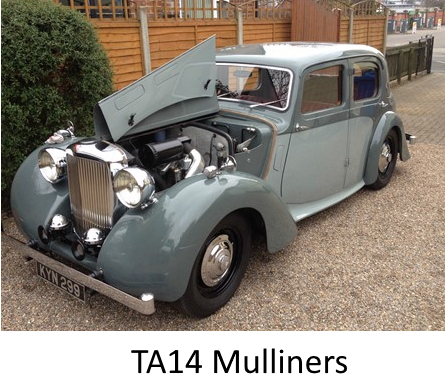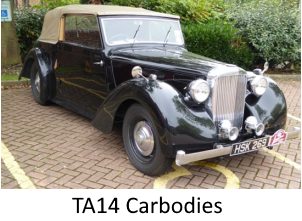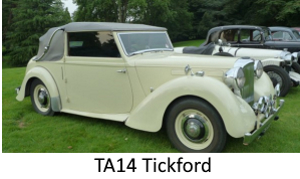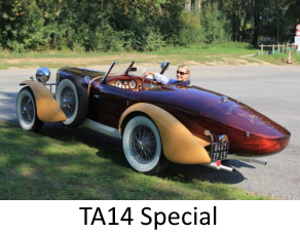TA 14 Description
The TA 14 has established itself as one of the most popular models made by Alvis. Prices have risen steadily over recent years particularly for the Drophead Models and TB 14s.
The world has changed almost beyond recognition since 1946. A period of time in reverse t would take us back to 1876, almost the dawn of the Motor Car. The manufacture of Alvis Cars from 1919 to 1967 is already a far shorter period than TA14s have been in existence.
The final chassis no. 23830 ran off the production line in December 1950 and the Model became history, the world moved on but the TA14 remains one of the most popular cars the Company ever built and has captured a devoted following of owners thus ensuring their place in the future.
Taking a Crystal ball to look forward over the next 70 years will no doubt show tremendous changes towards the end of the 21st Century.
Many of the Fourteens around now should still be going strong in the hands of caring owners. Fettling of the cars will increasingly be undertaken by specialists as modern day motoring does not develop those skills. Driving is likely to get less with the increasing age of the cars and intensification of traffic. Fewer long distance journeys will probably become the norm for most. Owners are already taking a much greater interest in the provenance of their cars. Increasing numbers are likely to migrate to countries such as Germany and the Netherlands. The Global spread covers over 15 countries around the globe and is rising.
For the increasingly scarce car beyond economic restoration there is a steady demand for the chassis to produce Specials particularly for the German market.
For a car that was once rather looked down upon as a Cinderella car the Fourteen is mow recognized all over the world as one, if not the finest cars Alvis ever built.
TA 14 Mulliners

The Mulliners Sports Saloon was the main version of the 4 year TA 14 production run. 1775 were made out of a production run of 3313 chassis. Alvis had investigated Charlesworth and other Coachbuilders but none could or would meet their production needs. With 1100 orders for car’s to be fulfilled and running chassis rolling off the production line Alvis turned to Mulliners. There seems to have been some suspicion over this arrangement on both sides. Alvis were worried that Mulliners might produce a more modern car body for their competitors that might highlight the pre-war style of the TA 14 and thus damage sales and the Company’s reputation. Following negotiations, a price was agreed and production of the new bodies began. The first 3 bodies presented to Alvis by Mulliners were rejected as being of poor quality. Alvis reputation as a manufacturer of quality car’s hung on the shoulders of the TA 14 and it was vital that the new car should not detract from that reputation. Eventually bodies were produced of sufficient quality.
Despite the Alvis factory having been destroyed in 1940 by a 2000lb bomb, six years later to the day after that destruction, 3 dealers and their wives came to take delivery of the first three Mulliners saloons off the production line. It had not been an easy path to that moment.
Mulliners bodies were made of steel and the original plan was to offer the ‘2 litre’ version together with a 3 litre engine option. The latter proved to be too ambitious and it was left to the sturdy 2 litre engine to carry the marque through to the 1950s and production of the 3 litres, although the TA 14 provided 3 prototype chassis for the development of the 3 litre model the TA 21.
The Mulliners was described as a Sports Saloon and the adverts of the day describe the handling as ‘holding the road beautifully at speed without roll or sway’.
The standard car came with an opening windscreen and all were fitted with a sliding Sunroof unless otherwise specified. Sadly many a Saloon met its fate due to extensive corrosion caused by blocked channels in the Sunroof and consequential rust.
For 3 years the Mulliners Saloon was the mainstay of Fourteen production. As it aged it became one of the less appreciated of the TA 14s. Fortunately the passage of time has shown what a good car the Saloon is and the increasing number of restored Saloons show why the car was so popular and produced a steady stream of orders.
TA 14 Carbodies

Having successfully bid to become the catalogued drophead of choice for Alvis they gave a price of £195 per body with a minimum order of 500. In the end they only produced 400.
Visually the line of chrome strips behind the back window is one of the key designs that diferentiates a Carbodies from a Tickford or other Drophead. Also the original hood style is single skinned and unlined. This gives the car more of a feel of a convertible when the hood is up. To a degree Carbodies worked down to a price for Alvis whereas the customers for the higher end drophead supplied by Tickford were felt to be less price sensitive.
One great benefit for Carbodies owners over the years has been substantially lower costs when commissioning a new hood and retrimming the car.
Today there is not much differentiation between the value of a Carbodies as opposed to a Tickford, the price being determined by the condition.
TA 14 Tickford

Alvis intended to limit the catalogued drophead version to Carbodies but the volume of chassis production meant that more Coachbuilders were needed to keep up with chassis production. Tickford of Newport Pagnell were approached and agreed to become involved.
Tickford were known for the production of high specification bodies, in terms of body, hood and trim.
The main differences from other TA 14 dropheads is that the body is made of light alloy panels on ash frames producing a lighter car. To identify the Tickford visually the hood is a good illustration with pram irons, a small glass rear window and being double skinned with a horse hair filling. Today many Tickfords sport cheaper hoods with a larger plastic rear window but most still carry their pram irons, thus avoiding the eye watering cost of replicating the original hood. When the hood is to the original specification it is like driving a saloon car when the hood is up. The interior trim and carpeting is considerably more complex than that of the Carbodies.
The original sale price was about £500 more than the equivalent Carbodies. For many years some owners tried to pass their Carbodies Drophead off as a Tickford.
TA 14 Shooting Brake and Utilities
What an eclectic bunch! In the early days of chassis production Alvis needed to move the chassis on and with the delays in finalising catalogued models the chassis could be bought and bodied by anyone who wanted to turn their hand to creating a new post war vehicle.
The road tax rules of the day made it attractive to run a utility vehicle Ron Walton’s fascinating book, ‘Young Ron’, still in print, tells amusing stories of road testing these vehicles when they returned to Alvis for approval and Guarantees. Needless to say some failed the test and there are instances of some catalogued bodies being built on chassis that had not achieved the required standard to run safely on the road. The majority of these vehicles were given bodies by reputable small coach builders and some fine examples were made that continue to thrive today. Many had busy lives in their younger days, bread delivery, furniture removal but one lucky vehicle went off to ‘work’ for Fortnum and Mason.
One ‘endearing’ feature of all the models has been the windscreen wipers. Woe betide the driver when flakes of snow begin to fall. The wipers glide across the screen packing the snow either side as visibility becomes smaller and smaller until it is necessary to lower the windows to try and clear the packed snow or stopping to get out to complete the task. Either way the elements are then free to enter the car. Few are the Fourteen drivers who do not have empathy with that experience!
Export overseas
Initially some early chassis were exported to Europe and some striking bodies were put on in Belgium and Switzerland. Some complete cars were exported to Sweden, Australia and New Zealand. Some smaller countries for example Uruguay took 11 cars.
TA 14 Other Coach Builders
A.P. Metalcraft TB 14
There must have been a few ‘Alvis’ men spluttering over their port when the TB 14 prototype was unveiled at the 1948 London Motor Show, the first Show after the war. Very much a Marmite car it was loved or hated. The design was based on the body produced by Bidee of Belgium. To add insult to injury the car did not carry the traditional Alvis radiator and looked as though it would be more at home cruising down the Boulevards of Santa Monica. This aberration was of course rectified when the 3 litre successor the TB21 was launched in 1951.
Whilst being clad in a striking 2 seater body the TB 14 remains a TA 14 with a 2 seater body hence the need for the relatively long boot to accommodate the chassis.
Twin carbs and a 4:3:1 differential were the main technical differences.
Norma Raffles demonstrated the other unusual features of the car at the Motor Show. Tucked away in the wide passenger door panel was a cocktail cabinet along with a vanity unit containing lipstick, powder and perfume for the lady passenger.
Neither made it into the production run of 100 although the cocktail cabinet has resurfaced occasionally in later life in some TB 14s. Possibly the most famous owner of a TB 14 was the actor James Mason but despite considerable research the chassis number and the car still remain a mystery.
Duncan
Alvis were pressurised heavily by the Post War government to increase the export of cars. Such pressure could not be ignored as the supply of scarce materials could be reallocated if the Company were not seen to be pulling their weight in the drive to earn foreign currency. The problem Alvis had in relation to car export was that their models were not necessarily attractive to some markets such as the Americans.
The Mulliners Saloon looked decidedly old fashioned to them and was not the essential 6 cylinder engine Americans wanted. After a visit to the USA an approach was made to Duncan to investigate the construction of a more ‘modern’ looking car. Duncan had already come up with their Fixed Head Saloon. Nothing was to come of the approach by Alvis but Duncan did body several cars with their individual design. Looking very much a car designed for the post war era the pillarless saloon was also very striking when seen with the doors wide open.
Specials

Sadly some cars, particularly the Mulliners saloons, have been viewed in the last as beyond restoration for various reasons. There will always be a debate over preservation versus re-bodying but in some instances it has been better that part of the car has been retained for the future. In the early days many Specials produced from Fourteens were somewhat underwhelming versions but now there are examples of superb Specials.
Perhaps the finest TA 14 Special is to be found today on the French roads. Created from a dilapidated and rather unsightly TA 14 Special, this car is the result of thousands of hours of painstaking work to produce a stunning 2 seater mahogany duck’s back.
Equally eye catching is the TA 14 ‘Hot Rod’ in pale green powered by a Buick engine. In many respects builders of Specials on a TA 14 chassis are continuing the process of building a body onto a 1940s chassis.
There will never be a time when the history and knowledge of Fourteens is complete, research continues and ‘barn finds’ still crop up. May the Force continue to be with the Fourteens, the world looks very promising for them. ‘Individuality’ still remains the watch word.